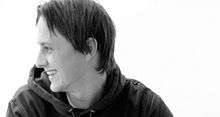Håvard Jørgensen
| Håvard Jørgensen | |
|---|---|
 | |
| Background information | |
| Birth name | Håvard Jørgensen |
| Also known as |
Haavard Lemarchand |
| Born |
26 September 1975 Oslo, Norway |
| Origin | Norway |
| Genres | Black metal, rock, pop |
| Occupation(s) | Musician, composer |
| Instruments | Guitars, vocals |
| Years active | 1992–present |
| Associated acts |
Ulver Satyricon Akki & Hojo C-Systems InPublik Snøhvitt |
Håvard Jørgensen, also known as Haavard, Lemarchand and Hojo, is a songwriter, guitarist and vocalist who has contributed in several bands and musical projects since the early 1990s, including Satyricon, Ulver, SCN, C-Systems, and Akki & Hojo and the genres span from black metal to pop-rock. Jørgensen is occupied with the alternative rock group Snøhvitt.
Career
Satyricon
One of the initiators of the band Eczema (which later on became Satyricon) which started up in 1991. Eczema won (as the first death metal-act) the Oslo Championship of Rock in 1992 – and changed thereafter the name to Satyricon.[1] Jørgensen participated on the first demo The Forest Is My Throne, but quit the band to join the newly founded Ulver in 1993.[2]
Ulver
Jørgensen was with Ulver from 1993 to 2000, and later as a session-guitarist.[3]
Akki and Hojo
Songwriter, vocalist and guitarist in Akki & Hojo from 2004-2008.
C-Systems
Vocalist and guitarist in C-Systems from 2008.
InPublik
Vocalist, guitarist and songwriter in InPublik from 2008–2011.
Inpublik were among the finalists in the web-based version of the Norwegian X Factor, Studio X in 2009.[4]
Snøhvitt
Vocalist, guitarist and songwriter in Snøhvitt from 2012–present.
Discography
Satyricon
- Satyricon (Demo, 1992)
Ulver
- Rehearsal 1993 (1993)
- Vargnatt (1993)
- Bergtatt - Et Eeventyr i 5 Capitler (1994)
- Kveldssanger (1995)
- Nattens Madrigal - Aatte Hymne til Ulven i Manden (1996)
- The Trilogie - Three Journeyes through the Norwegian Netherworlde (1997)
- Themes from William Blake's The Marriage of Heaven and Hell (1998)
- Metamorphosis (1999)
- Perdition City (2000)
- Blood Inside (2005)
- Gods of Thunder: A Norwegian Tribute to Kiss (2005) - Strange Ways
- Trolsk Sortmetall 1993-1997 (2014)
The Mindtrip Project
- Fragmentation EP (2000) – Departure and Content Zero
SCN
- Inside Out (2001) – Guitars on All Tied Up and So Free
Head Control System
- Murder Nature (2006) – Lead guitars on Masterpiece (of Art) and Rapid Eye Movement
Akki and Hojo
- Skyfri (Single, 2006) – Vocals and guitars
- Angel on Guard (Single, 2006) – Songwriter and guitars
C-Systems
- Close my eyes (Single, 2008) – Guitars
- Don't Turn Around (Single, 2009) – Lyrics and vocals
References
- ↑ "Ulver Discography". Encyclopedia Metallum. Retrieved 13 June 2010.
- ↑ "Satyricon". Encyclopedia Metallum. Retrieved 13 June 2010.
- ↑ "Ulver Discography". Metal Kingdom. Metal Kingdom. Retrieved 13 June 2010.
- ↑ The Rachel Iren Mathisen (27 November 2009). "Inpublik er Finalister". Groruddalen (in Norwegian). Retrieved 13 June 2010.